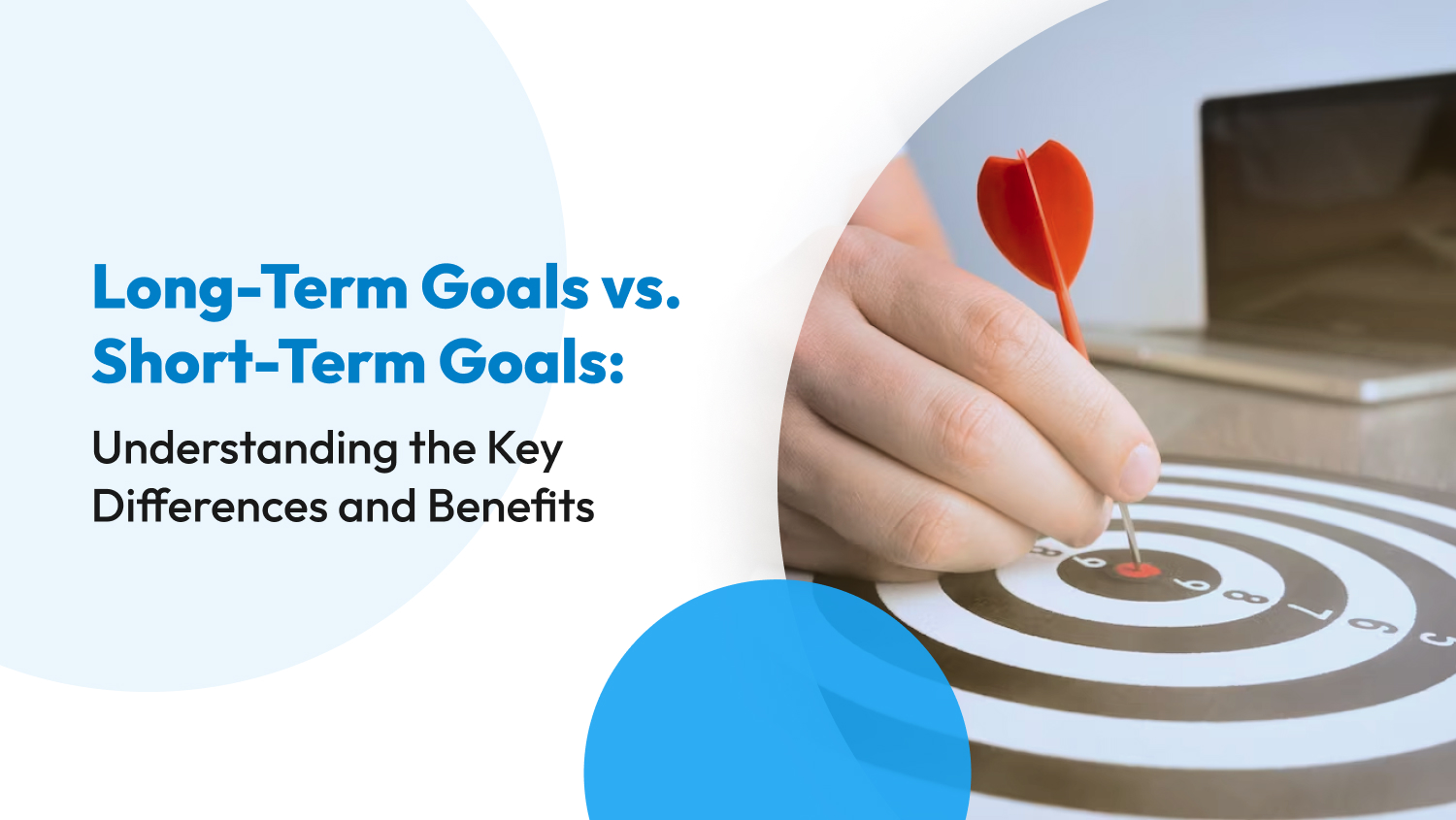Business
Long-Term Goals vs. Short-Term Goals: Understanding the Key Differences and Benefits
Setting goals is essential to your personal and professional growth. Without goals, finding direction and motivation for everything you do is difficult. Having goals is your first step to fulfillment.
Goals are classified into two categories: long-term and short-term. In this article, we’ll define both, discuss their benefits, and give examples of each. Whether you’re a go-getter employee or a solopreneur, this information will help shape your path and create a roadmap to your desired life.
Defining Long-Term and Short-Term Goals: Understanding the Basics
Long-term goals take months or even years to achieve. These goals are made to give your life purpose, pushing you always to make informed and wise decisions that align with your long-term vision.
Moreover, long-term goals require a careful and focused approach. They require sustained effort and sacrifices to accomplish. They’re the complete embodiment of the concept of “delayed gratification,” wherein immediate benefits are sometimes discarded for a better and more fulfilling reward in the far future.
On the other hand, short-term goals are easily attained today, this week, this month, or this year. They could also be stepping stones to your overall long-term goal — little tasks you could do to get closer to your grand reward.
Short-Term Goals: Success in Little Steps
To set yourself up for success with short-term goals, you must never forget to create SMART goals. These are the following:
- Specific: Make detailed goals
- Measurable: Establish quantifiable progress and rewards
- Achievable: Set realistic goals that you can attain with your resources
- Relevant: Ensure that your short-term goals will have a lasting impact
- Time-Bound: Create goals that can be achieved with a defined deadline
Fortunately, several productivity tools can help you set SMART goals, like ClickUp and Notion. You can also use calendar applications like Google Calendar and Apple Calendar to ensure you’re on track. You can check out our comparison of the two calendar platforms here.
Furthermore, you can also utilize workflow frameworks like Agile to keep yourself focused and progressing smoothly. In Agile, short-term goals are called “sprints,” which are essential to project management to ensure no tasks are left behind.
Long-Term Goals: Create Your Future
When it comes to long-term goals, you must take a step back and reflect on your overall goals before making decisions. Paint the bigger picture in your mind vividly and determinedly chase that dream.
Set difficult but achievable goals — this will motivate you to attain these goals. By aiming for goals that push the boundaries of your capabilities, you encourage continuous learning and improvement.
Furthermore, you can break down long-term goals into several short-term ones to ensure steady progress. These short-term milestones can act as checkpoints along the way, giving you a sense of accomplishment.
Lastly, be proactive and not passive. According to entrepreneur Michael Mogill, here are the eight steps to being proactive in goal setting:
- Be accountable
- Be consistent
- Be honest
- Be solution-focused
- Make your own luck
- Rely on yourself
- Surround yourself with the right people
- Use SMART goals
In other words, don’t be afraid to change and adapt. Your goals on day one wouldn’t be exactly the same today. However, that doesn’t mean you have to compromise your overall vision — it just means you have to make small changes to achieve it.
Sometimes, being enough won’t cut it — we must go beyond what we thought we could do to significantly impact society. This is possible through stretch goals, which are set to challenge you and take you outside your comfort zone. Stretch goals could also be classified as long-term goals, especially for new entrepreneurs.

Real-Life Examples of Professional Long-Term and Short-Term Goals
Definitions aren’t enough — examples are essential in explaining these goals and what they could achieve for you. The following are some examples of long-term and short-term goals and how they could ultimately drive you to be a better individual:
Examples of Long-Term Goals
- Acquire a degree in your chosen field: Gain trust in your potential line of work.
- Be a known individual in your favorite hobby: Establish respect for your contributions in the niche.
- Establish a successful network of like-minded individuals within your industry: Create a platform where you and others like you can exchange ideas.
- Get a leadership position in your company: Achieve better rewards for your work and be a respected figure in your business.
- Obtain financial freedom: Be free from expenses that cost an arm and a limb.
Examples of Short-Term Goals
- Learn a skill by completing a short course and get a certification: Beneficial in building your resume or upgrading your capabilities as a contributing member of society.
- Create a time management system: Never miss a deadline again.
- Develop a reading habit: Reading contributes to your overall productivity. In fact, a report shows that 88% of self-made millionaires maintain a reading habit.
- Increase your reputation in the industry by maintaining a blog: Create an avenue where you can freely share your thoughts.
- Learn how to use a new software or tool: Upskilling helps your employability. Many industry leaders believe that upskilling is the optimal way to circumvent the rise of artificial intelligence tools.

Creating Long-Term and Short-Term Objectives in Business
Long-term and short-term goals aren’t only essential in our personal lives — it’s also crucial in business. Entrepreneurs must set objectives that their team members must follow to ensure their business survives and thrives. The following are some long-term goals businesses can set:
- Create co-beneficial partnerships in your space: According to Microsoft, 95% of their revenue comes from partnerships with other brands. Establishing partnerships doesn’t only boost your revenue, but it can also create new jobs and opportunities.
- Expand your market presence and establish a global brand identity: If your goal is to be a global company, it’s important to create a recognizable brand identity that customers can trust. As a testament to this, a 2021 report by Lucidpress shows that brand consistency leads to revenue growth by at least 10%.
- Foster a sustainable workplace and employ environmentally conscious practices: Going green is essential to a business’s social responsibility. A 2017 survey by Cone Communications reveals that 63% of Americans support a brand leader in social and environmental issues.
Businesses don’t have a shortage of short-term goals either. Listed are some short-term goals that you can set to create more opportunities for your venture:
- Establish a help desk for your customers: Having robust customer service boosts your audience’s trust in your brand. Microsoft reports that 68% of consumers tend to lean positively toward a brand when they have a proactive help desk.
- Increase monthly sales from last month’s numbers: Don’t be complacent with last month’s numbers, even if they’re good. Always aim for better returns and create effective changes to accomplish that.
- Streamline business processes through automation: According to McKinsey, half of today’s work can be automated. This means saving time and money, as well as improving productivity since you can task your team to do more meaningful work.
The Bottom Line
We can’t be without direction in everything that we do. There must always be an objective in mind — something to strive towards and motivate you to do better. Whether they’re long-term or short-term goals, what’s important is that you’ll always use them as a guide for your actions.
However, there must always be a balance between short-term and long-term goals. You can’t only focus on your long-term objective because doing so prevents you from living in the present. On the other hand, fixating on short-term rewards can also stop you from reaching your overall vision.
Our advice? Create a mental or physical list of everything you want to achieve long-term and short-term. This helps make your goals tangible and allows you to focus on those objectives, make wise choices, and lead a life worth living.











